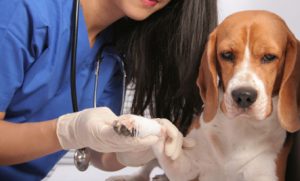Listen to this post |
 Diabetes mellitus, commonly referred to simply as diabetes, is a disease seen occasionally in dogs, and commonly in cats. The end result of this disease is high blood glucose due to the inability of the body cells to absorb dietary sugar. Before understanding what causes diabetes and the best way to manage it from a holistic perspective, it is first necessary to understand the mechanism of the disease.
Diabetes mellitus, commonly referred to simply as diabetes, is a disease seen occasionally in dogs, and commonly in cats. The end result of this disease is high blood glucose due to the inability of the body cells to absorb dietary sugar. Before understanding what causes diabetes and the best way to manage it from a holistic perspective, it is first necessary to understand the mechanism of the disease.
Under normal circumstances, after carbohydrates are broken down into simple sugars (a.k.a., glucose) and absorbed in the digestion process, glucose then enters the blood stream. Chemo-receptors in the blood vessels detect the spike in blood glucose, and then signal the islet cells of the pancreas to secrete a hormone called insulin. Insulin attaches to insulin receptors on cells that trigger the cells to take up the glucose. Glucose is then either utilized for energy, or stored for later use by the cells during periods of low blood glucose (hypoglycemia). This process generally keeps a dog’s blood glucose between 80-120, and a cat’s blood glucose between 80-180.
Diabetes results when either the islets cells of the pancreas lack the ability to secrete adequate levels of insulin in response to absorbed dietary glucose, or the cellular insulin receptors are unresponsive to insulin. Either scenario may occur for genetic reasons due to inherited defects of pancreatic islet cells, cellular insulin receptors, or both. These cases are called Type I diabetes, or insulin dependent diabetes. Either scenario may also occur due to refractoriness or exhaustion of the pancreatic islet cells and/or cellular insulin receptors due to obesity and diets overly rich in simple carbohydrates and fat. 95% of canine diabetics are type I diabetics. Oppositely, 95% of cats are type II diabetics. This means that for dogs, the vast majority of cases of diabetes represent a genetic ticking time bomb where there was little that the owner could have done to prevent; whereas for cats, the vast majority of cases of diabetes were the result of poor diet, lifestyle, and obesity, all very preventable circumstances.
Please bear in mind that just because most diabetic cats are non-insulin dependent diabetics, does not mean that they may not need insulin. In fact, many do. However, unlike dogs, it does mean that with proper diet, there is a chance that a feline diabetic may be able to get weaned off insulin injections over time (about 20%-30% of the time if the correct diet and insulin are chosen). On the other hand, if a feline has a blood glucose over 400, DO NOT TRY TO TREAT THE DIABETES WITH DIET ALONE. Leaving the blood glucose that high leaves the cat prone to neurological disease, skin and bladder infections, blood vessel injury, kidney damage, and a life threatening complication of diabetes called diabetic ketoacidosis.
For dogs, the majority of the time, since they are insulin dependent diabetics, it is unrealistic to think that you will successfully wean them off dependence on insulin. However, with natural management with proper diet, exercise, and supplementation, you can minimize the deleterious effects of diabetes on the body, while minimizing insulin doses, which tend to otherwise progressively increase over time. Thus, let us start with canine diabetic management.
The most important point I can make about diabetes, is that since high blood glucose is the end result and primary harmful health consequence of the disease, we need to avoid simple carbohydrates and sugars. Diabetic dogs should be fed high protein (27%-50% of their total daily nutrient intake), no more than 18% fats, and the rest complex carbohydrate and fiber. There are prescription and commercial diets available that meet these criteria, but you need to research and do your due diligence to find them. Ideally, you should avoid feeding diets that are heavy in refined grains or even grain free if possible.
If time and schedule permits, home prepared diets with fresh, unprocessed ingredients are excellent, sticking to the aforementioned general diabetic dietary guidelines as best you can. You can likely achieve this balance by feeding 50% lean meats (poultry, venison, lamb) with 50% fresh vegetables and sparing amounts of fruits safe for canine consumption (pears, apples). Good vegetable choices include green beans and broccoli. If your dog is not crazy about vegetables, pureeing them into a paste or steaming them can make them more appealing.
Another important point about diet with regard to management of diabetes is body condition, whether or not a dog is obese. If your dog is obese, dietary portion control and exercise are of the utmost importance. Obesity continually stresses the pancreas and blood glucose metabolism, making it increasingly difficult to regulate diabetes. Obesity also increases the potential for inflammatory disease of the blood vessels (more on this below) and dangerous clot formations.
I strongly advise pharmaceutical grade omega-3-fatty acids supplementation for diabetic dogs, as inflammation and secondary infections at the level of the skin and urinary bladder are common complications of diabetes. Inflammatory disease in the blood vessels of the body (vasculitis) is also a common complication of diabetes in dogs. Omega-3-fatty acids directly condition and nourish these and other tissues and organ systems, while naturally exerting an anti-inflammatory effect.
With regard to cats, from a supplemental and obesity management point of view, the same applies as it does for dogs. The main difference for management of feline diabetes is dietary. Whereas dogs require complex carbohydrate and fiber in their diet, most cats do not. Cats are in the truest sense, carnivores, meaning that their bodies can synthesize any nutrient they require from meat protein. Thus, diabetic cats (as well as all cats, for that matter), ideally should be fed a diet that consists of 80%-90% meat based protein.
Like dogs, commercial and prescription diets exist that fit these criteria, but it is important to take a close look at the ingredients and nutrient percentage breakdowns prior to choosing a diet for your cat. One sure method to ensure proper nutrient consumption is to prepare home cooked diets for your cat. The ingredients would be much like those described above for dogs, however, I would instead feed 80% meat to 20% vegetables, or even 100% meat provided the cat maintains good GI function fed a pure meat diet.
Dr. Roger Welton is a practicing veterinarian and highly regarded media personality through a number of topics and platforms. In addition to being passionate about integrative veterinary medicine for which he is a nationally renowned expert, Dr. Welton was also an accomplished college lacrosse player and remains to this day very involved in the sport. He is president of Maybeck Animal Hospital , runs the successful veterinary/animal health blogs Web-DVM and Dr. Roger’s Holistic Veterinary Care, and fulfills his passion for lacrosse through his lacrosse and sport blog, The Creator’s Game.



